The Originals – Elvis Presley Vol. 2
The first part of the Elvis Originals covered (as it were) the Rock & Roll years and early post-GI period. Here we have the originals of songs Elvis covered in the 1960s and ’70s.
Elvis Presley’s artistic decline in the1960s is symbolised by the coincidence of his most derided movie, Clambake, which opened at about the same time as The Beatles released their groundbreaking Sgt Pepper’s Lonely Hearts Club Band LP. A year later, in 1968, Elvis’ live TV special marked the comeback of Elvis the Entertainer. Elvis the Recording Artist, however, had not had a #1 hit in seven years when in January 1969 he entered the famous American Sound Studios in Memphis.
At first the old soul music veterans at the studio were dubious about working with the washed-up ex-king of rock ‘n’ roll. Elvis soon had them convinced otherwise. Eight days into the session, on January 20, he recorded the Mac Davis-penned In The Ghetto; two days later Suspicious Minds, which by the end of 1969 would top the US charts.
Suspicious Minds was written by American Sound Studios in-house writer Mark James (whose real name was Francis Zambon), who also wrote hits such as It’s Only Love and Hooked On A Feeling for his friend, country singer BJ Thomas. And it was BJ Thomas was in line to record Suspicious Minds, which James had already released on record to no commercial success, before the song was given to Presley. Elvis insisted on recording the song even when his manager, “Colonel” Tom Parker, threatened that he wouldn’t over the question of publishing rights (always an issue with Parker).
Elvis would record four more songs written or co-written by James: Always On My Mind, Raised On A Rock, Moody Blue (which James released in 1975) and It’s Only Love. Chips Moman produced James’ 1968 version of Suspicious Minds, thereby creating a handy template which he returned to when producing Elvis’ version.
Depending on where you live and how old you are, Always On My Mind may be Elvis’ song or Willie Nelson’s, or perhaps the Pet Shop Boys’ (who had a hit with it in late 1987 after earlier performing it on a TV special to mark the 10th anniversary of Elvis’ death). Originally it was Brenda Lee’s, released in May 1972. It was not a big hit for her, reaching only #45 in the country charts. Somehow Elvis heard it and found the lyrics expressed his emotions at a time when the marriage to Priscilla was collapsing. He recorded it later in 1972. Released as the b-side to the top 20 hit Separate Ways, Always On My Mind was a #16 hit in the country charts. In the UK, however it was a top 10 hit, and became better know in Europe than in the US.
Another artist whose songs Elvis loved to cover was Jerry Reed, featured here with Guitar Man and US Male, originally released by Reed in 1966 and covered by Elvis two years later. Jerry Reed was a country singer who toiled for a dozen years before scoring a hit in 1967 with Tupelo Mississippi Flash — a song about Elvis. The same year Elvis chose to record Reed’s Guitar Man (the composer is listed as Jerry Hubbard, the singer’s real surname), and Reed played guitar on it. For Elvis, Guitar Man was a redemption of sorts after the degradation of Clambake. His performance of the song at the Elvis ’68 Comeback Special is one of the best moments of the show.
The writers most associated with Elvis are Jerry Leiber & Mike Stoller. Their Bossa Nova Baby has been unjustly regarded by some as a novelty number from an Elvis movie (1963’s Fun In Acapulco). Even Elvis is said to have been embarrassed by it. If so, he had no cause: it may not be a bossa nova — it’s too fast for that — but it has an infectious tune and a genius keyboard riff which begs to be sampled widely. Perhaps it was the lyrics which had Elvis allegedly shamefaced, but the lines “she said, ‘Drink, drink, drink/Oh, fiddle-de-dink/I can dance with a drink in my hand’” are not much worse than some of the doggerel our man was forced to croon in his movie career as singing racing driver/pineapple heir/bus conductor. Or perhaps Elvis was embarrassed by the idea of including a notional bossa nova number in a movie set in Mexico.
Tippie & the Clovers, who were signed to Leiber and Stoller’s Tiger label, recorded it first in 1962 to cash in on the bossa nova craze. Apparently the composer’s preferred the Clovers’ version over Elvis’. These were the same Clovers, incidentally, who had scored a #23 hit with Love Potion No. 9 (also written by Leiber & Stoller and later covered to greater chart effect by the Searchers) on Atlantic in 1959.
Elvis was greatly influenced by the sounds of Rhythm & Blues on the one hand and country music on the other — Arthur Crudup and Hank Snow. A third profound influence was gospel. Here, too, Elvis drew from across the colour line. Often he was one of the few white faces at black church services (as a youth in Tupelo, he lived in a house designated for white families but located at the edge of a black township), but he also loved the white gospel-country sounds created by the likes of the Louvin Brothers, whom he once regarded as his favourite act.
Indeed, gospel was the genre Elvis loved the most. In recording studios, he would warm up with gospel numbers. When he jammed with Jerry Lee Lewis and Carl Perkins in the Sun studio (Johnny Cash left before any of the misnamed Million Dollar Quartet session was recorded), much of the material consisted of sacred music. At the height of his hip-gyrating greatness, he recorded an EP of spirituals titled Peace In The Valley. And let’s not forget that the only three Grammies Elvis ever received were for gospel recordings.
Elvis’ biggest gospel hit was Crying In The Chapel, which had been written in 1953 by Artie Glenn for his son Darrell, who performed it in the country genre. The same year, the R&B band Sonny Til & the Orioles — progenitors of the doo wop style of the late ’50s and the first of a succession of bird-themed bandnames — scored a #11 hit with the song (around the same time, a pop version by June Valli reached #4). It was the Orioles’ recording from which Elvis drew inspiration in his version, recorded shortly after he returned from the army in 1960. It was not released, at Tom Parker’s command, because Artie Glenn refused to share the rights to the song with the cut-throat publishing company of Elvis repertoire, Hill & Range. And with good reason, for the song continued to be a hit by several artists. Eventually Hill & Range secured the ownership. When Crying In The Chapel was eventually released in 1965, it was not only a US hit (his first top 10 single in two years), but also topped the UK charts.
Apparently written for Perry Como, The Wonder Of You was first recorded by Ray Peterson (he of Tell Laura I Love Her notoriety) in 1959, scoring a moderate hit with it. Peterson, who died in 2005, later liked to recount the story of how Elvis sought his permission to record the song. “He asked me if I would mind if he recorded The Wonder Of You. I said: ‘You don’t have to ask permission; you’re Elvis Presley.’ He said: ‘Yes, I do. You’re Ray Peterson.’” Not that Peterson owned the rights to the song, or was particularly famous for singing it.
Elvis recorded the song live on stage in Las Vegas on February 18, 1970. It was released as a single a couple of months later and was a big hit on both sides of the Atlantic, topping the UK charts for six weeks. It was also his last UK #1 during his lifetime.
Elvis did not particularly like Burning Love; if he didn’t record it under protest, he certainly was not going to spend much time on it. Where 16 years earlier he’d spend 30-odd takes on the spontaneous sounding Hound Dog, he recorded Burning Love in only six takes. The production values were pretty poor: Elvis’ voice sounds tinny, but not for lack of trying. But listen to the drumming! Strange then that this slack recording scored big in the US (#2 on Billboard; the final top 10 hit in his lifetime) and UK (#7).
A year previously, in 1971, the soul singer Arthur Alexander (whom we will meet again when we turn to originals of Beatles songs) recorded Burning Love, releasing it in January 1972, two months before Elvis recorded it. A fine recording in the southern soul tradition, it made no impact. The song’s writer, Dennis Linde, recorded it in 1973 — his version, included here, recalls the sound of Creedence Clearwater Revival.
With its Bo Diddley-inspired guitar riff and flamenco-meets-rock ‘n’ roll feel, 1961’s (Marie’s The Name) His Latest Flame served as a welcome, albeit temporary, break from Elvis’ succession of easy listening fare such as It’s Now Or Never, Surrender and Are You Lonesome Tonight (though within a few months, he’d top the charts with another standard ballad, Can’t Help Falling In Love). Like all these songs, His Latest Flame was not an original.
The song was written by Doc Pomus and Mort Shuman, who wrote some 20 Elvis songs — including Viva Las Vegas, their demo of which is included here — as well as hits for acts such as The Drifters (Save The Last Dance For Me) and Dion (Teenager In Love). Although reportedly written specifically for Elvis, His Latest Flame was first offered to Bobby Vee, who turned it down. Instead Del Shannon recorded the song in May 1961, with a view to releasing it as a follow-up single for his big hit Runaway. In the event, he decided to run with the non-classic Hats Off To Larry instead. His Latest Flame was released on the Runaway With Del Shannon LP in June ’61. The same month Elvis recorded his version, which was released in the US in August. Due to the arcane method of compiling the US charts, the His Latest Flame peaked at #4 and its flip side, Little Sister (another Pomus/Shuman composition) at #5. It topped the charts in Britain.
Shuman tended to tout his co-composition by way of demos on which he sang himself. The demo for His Latest Name is much closer to Elvis’version than Shannon’s, a less smooth, more soulful interpretation which has something of a mariachi band feel, using brass to accentuate the Diddley-style riff (which the Smiths famously sampled 24 years later on Rusholme Ruffians).
It’s Now Or Never and Surender were based on old Italian songs; Can’t Help Falling In Love on an old French melody. This is the song which ignorant callers to radio stations tend to request by the title “Wise Man Say”. The fictitious title is not entirely off the mark: the lyrics were co-written by a pair of alleged mafia associates, Hugo Peretti and Luigi Creatore, with George David Weiss. Peretti and Creatore were partners with mafioso Mo Levy in the Roulette record label (named after the game that “Colonel” Tom Parker was addicted to), which the FBI identified as a source of revenue for the Genovese crime family. The trio also wrote the lyrics for The Lion Sleeps Tonight, a song stolen from South African musician Solomon Linda.
The melody of Can’t Help Falling In Love borrows from the old French love song Plaisir d’amour, composed in 1785 by Johann Paul Aegidius Martini. It was first recorded in 1902 by Monsieur Fernand (real name Emilio de Gogorza), and subsequently by a zillion others, including in 1908 by the baritone Charles Gilibert (1866-1910). It may be a little more accurate to describe Can’t Help Falling In Love as an adaptation rather than as a cover. While the similarities are sufficiently evident to mark Plaisir d’amour as the basis for the song, it certainly has been innovated on.
The song was adapted in 1961 for Elvis’ Blue Hawaii movie (the title track was a cover of a Bing Crosby song, of all things). Reportedly, neither the film’s producers nor Elvis’ label, RCA, liked the song much. Elvis, however, insisted on recording it. Elvis often was his best A&R man, and so it was here. The song was initially released as the b-side of Rock-A-Hula Baby (you do know how that one goes, no?). In the event, Can’t Help became the big hit, reaching #2 in the US and #1 in the UK. It also became a signature song for Elvis who would invariably include it in his concerts. Indeed, it was the last song he performed live on stage in Indianapolis on 26 June 1977, Elvis’ final concert.
The last five tracks in the mix are demo versions recorded by the songs’ composers. And in the case of A Little Less Conversation, Elvis was the progenitor for the later version which became a hit in 2002 under the Elvis vs JXL moniker.
1. Del Shannon – His Latest Flame (1961)
2. Clyde McPhatter & The Drifters – Such A Night (1956)
3. The Coasters – Girls! Girls! Girls! (1962)
4. Tippie & the Clovers – Bossa Nova Baby (1962)
5. Jerry Reed – Guitar Man (1967)
6. Mark James – Suspicious Minds (1968)
7. Arthur Alexander – Burning Love (1972)
8. Tony Joe White – I’ve Got A Thing About You Baby (1972)
9. Jerry Reed – U.S. Male (1966)
10. Wynn Stewart – Long Black Limousine (1958)
11. Brenda Lee – Always On My Mind (1972)
12. Ferlin Husky – There Goes My Everything (1966)
13. Ray Peterson – The Wonder Of You (1959)
14. Micky Newbury – An American Trilogy (1971)
15. Tony Joe White – Polk Salad Annie (1968)
16. Mark James – Moody Blue (1975)
17. Buffy Sainte-Marie – Until It’s Time For You To Go (1965)
18. Les Paul & Mary Ford – I Really Don’t Want To Know (1954)
19. Darrell Glenn – Crying In The Chapel (1953)
20. Bing Crosby – Blue Hawaii (1937)
21. Charles Gilibert – Plaisir d’amour (1908)
22. Elvis Presley – A Little Less Conversation (1968)
23. Laying Maetine Jr. – Way Down (1976)
24. Mort Shuman – His Latest Flame
25. Mort Shuman – Viva Las Vegas
26. Bill Giant – Devil In Disguise
27. Dennis Linde – Burning Love





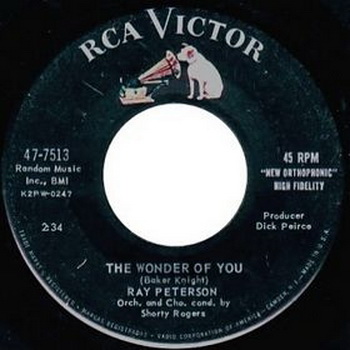

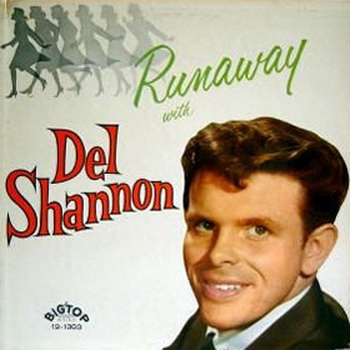


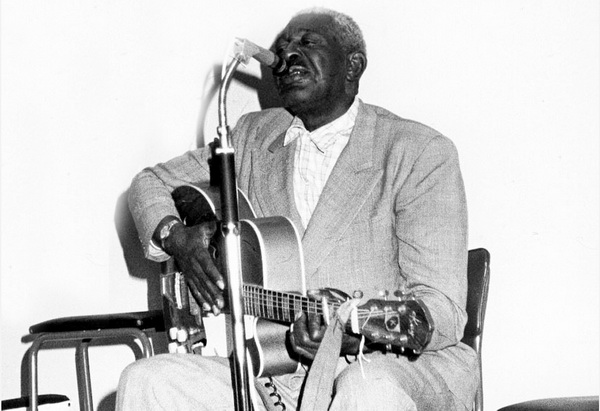

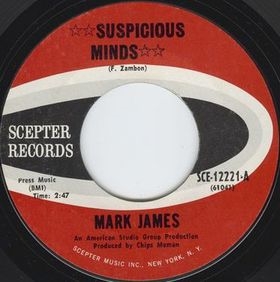 Suspicious Minds was written by American Sound Studios in-house writer Mark James (whose real name was Francis Zambon), who also wrote hits such as It’s Only Love and Hooked On A Feeling for his friend, country singer BJ Thomas. The latter was also a UK hit for the vile Jonathan King. BJ Thomas was in line to record Suspicious Minds before the song was given to Elvis — who insisted on recording the song even when his manager, “Colonel” Tom Parker, threatened that he wouldn’t over the question of publishing rights (always an issue with Parker). Thomas went on to have a big hit that year anyway with Raindrops Keep Falling On My Head, and went on to record Suspicious Minds in 1970.
Suspicious Minds was written by American Sound Studios in-house writer Mark James (whose real name was Francis Zambon), who also wrote hits such as It’s Only Love and Hooked On A Feeling for his friend, country singer BJ Thomas. The latter was also a UK hit for the vile Jonathan King. BJ Thomas was in line to record Suspicious Minds before the song was given to Elvis — who insisted on recording the song even when his manager, “Colonel” Tom Parker, threatened that he wouldn’t over the question of publishing rights (always an issue with Parker). Thomas went on to have a big hit that year anyway with Raindrops Keep Falling On My Head, and went on to record Suspicious Minds in 1970. Elvis would record four more songs written or co-written by James: Always On My Mind (written originally, as noted in
Elvis would record four more songs written or co-written by James: Always On My Mind (written originally, as noted in  The influence on Elvis’ early music by the sounds of Rhythm & Blues on the one hand and country music on the other — Arthur Crudup and Hank Snow — is well known. A third profound influence was gospel. Here, too, Elvis drew from across the colour line. Often he was one of the few white faces at black church services (as a youth in Tupelo, he lived in a house designated for white families but located at the edge of a black township), but he also loved the white gospel/country sounds created by the likes of the Louvin Brothers — whose charmless sibling Ira once declined an approach by his fan Elvis, citing his reluctance to speak to the “white nigger”.
The influence on Elvis’ early music by the sounds of Rhythm & Blues on the one hand and country music on the other — Arthur Crudup and Hank Snow — is well known. A third profound influence was gospel. Here, too, Elvis drew from across the colour line. Often he was one of the few white faces at black church services (as a youth in Tupelo, he lived in a house designated for white families but located at the edge of a black township), but he also loved the white gospel/country sounds created by the likes of the Louvin Brothers — whose charmless sibling Ira once declined an approach by his fan Elvis, citing his reluctance to speak to the “white nigger”. Elvis’ biggest gospel hit was Crying In The Chapel, which had been written in 1953 by Artie Glenn for his son Darrell, who performed it in the country genre. The same year, the R&B band Sonny Til & the Orioles — progenitors of the doo wop style of the late ’50s and the first of a succession of bird-themed bandnames — scored a #11 hit with the song (around the same time, a pop version by June Valli reached #4). It was the Orioles’ recording from which Elvis drew inspiration in his version, recorded shortly after he returned from the army in 1960. It was not released, at Tom Parker’s command, because Artie Glenn refused to share the rights to the song with the cut-throat publishing company of Elvis repertoire, Hill & Range. And with good reason, for the song continued to be a hit by several artists. Eventually Hill & Range secured the ownership. When Crying In The Chapel was eventually released in 1965, it was not only a US hit (his first top 10 single in two years), but also topped the UK charts.
Elvis’ biggest gospel hit was Crying In The Chapel, which had been written in 1953 by Artie Glenn for his son Darrell, who performed it in the country genre. The same year, the R&B band Sonny Til & the Orioles — progenitors of the doo wop style of the late ’50s and the first of a succession of bird-themed bandnames — scored a #11 hit with the song (around the same time, a pop version by June Valli reached #4). It was the Orioles’ recording from which Elvis drew inspiration in his version, recorded shortly after he returned from the army in 1960. It was not released, at Tom Parker’s command, because Artie Glenn refused to share the rights to the song with the cut-throat publishing company of Elvis repertoire, Hill & Range. And with good reason, for the song continued to be a hit by several artists. Eventually Hill & Range secured the ownership. When Crying In The Chapel was eventually released in 1965, it was not only a US hit (his first top 10 single in two years), but also topped the UK charts. Apparently written for Perry Como, The Wonder Of You was first recorded by Ray Peterson (he of Tell Laura I Love Her notoriety) in 1959, scoring a moderate hit with it. Peterson, who died in 2005, later liked to recount the story of how Elvis sought his permission to record the song. “He asked me if I would mind if he recorded The Wonder Of You. I said: ‘You don’t have to ask permission; you’re Elvis Presley.’ He said: ‘Yes, I do. You’re Ray Peterson.’” Not that Peterson owned the rights to the song, or was particularly famous for singing it.
Apparently written for Perry Como, The Wonder Of You was first recorded by Ray Peterson (he of Tell Laura I Love Her notoriety) in 1959, scoring a moderate hit with it. Peterson, who died in 2005, later liked to recount the story of how Elvis sought his permission to record the song. “He asked me if I would mind if he recorded The Wonder Of You. I said: ‘You don’t have to ask permission; you’re Elvis Presley.’ He said: ‘Yes, I do. You’re Ray Peterson.’” Not that Peterson owned the rights to the song, or was particularly famous for singing it. This song is probably most famous in its incarnation as Engelbert Humperdinck’s gaudy 1967 hit. In its original form, however, it is a country classic, written by Dallas Frazier. It was first recorded in 1965 and released the following year by that great purveyor of unintentionally funny songs and owner of the hickiest of hick accents, Ferlin Husky. His version was an album track; fellow country singer Jack Greene turned it into a hit in 1967. Elvis’ version, which appeared on the quite excellent 1971 Elvis Country album (after being a 1970 b-side of I Really Don’t Want To Know) and was a UK top 10 hit that year, certainly draws from the song’s country origins — though surely not from Husky’s original.
This song is probably most famous in its incarnation as Engelbert Humperdinck’s gaudy 1967 hit. In its original form, however, it is a country classic, written by Dallas Frazier. It was first recorded in 1965 and released the following year by that great purveyor of unintentionally funny songs and owner of the hickiest of hick accents, Ferlin Husky. His version was an album track; fellow country singer Jack Greene turned it into a hit in 1967. Elvis’ version, which appeared on the quite excellent 1971 Elvis Country album (after being a 1970 b-side of I Really Don’t Want To Know) and was a UK top 10 hit that year, certainly draws from the song’s country origins — though surely not from Husky’s original. Elvis did not particularly like Burning Love; if he didn’t record it under protest, he certainly was not going to spend much time on it. Where 16 years earlier he’d spend 30-odd takes on the spontaneous sounding Hound Dog (see
Elvis did not particularly like Burning Love; if he didn’t record it under protest, he certainly was not going to spend much time on it. Where 16 years earlier he’d spend 30-odd takes on the spontaneous sounding Hound Dog (see 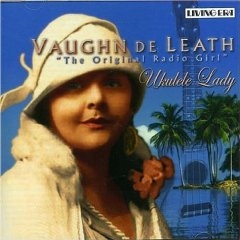 Tom Parker got Elvis to sing this old standard because it was a favourite of his wife, Mrs Marie (!) Parker, in its 1940s version by country star Gene Austin. Written by Tin Pan Alley residents Lou Handman and Roy Turk in 1926, it was recorded by a swathe of artists in 1927. The first of these versions, by Ned Jakobs, was not released, so the honour of first released recording goes to one Charles Hart. The song first became a hit in the version by the improbably named Vaughn Deleath, “The Radio Girl”. Her take dates to June 13 (Hart’s was May 8). On August 5, 1927, the famed tenor Henry Burr put his voice to it. Many a crooner would follow, but some performers adapted the song to their genre. So it was with the Carter Family — the pioneers of country music who went on to produce June and Anita — whose quite lovely 1935 bluegrass version is barely recognisable, musically and even lyrically.
Tom Parker got Elvis to sing this old standard because it was a favourite of his wife, Mrs Marie (!) Parker, in its 1940s version by country star Gene Austin. Written by Tin Pan Alley residents Lou Handman and Roy Turk in 1926, it was recorded by a swathe of artists in 1927. The first of these versions, by Ned Jakobs, was not released, so the honour of first released recording goes to one Charles Hart. The song first became a hit in the version by the improbably named Vaughn Deleath, “The Radio Girl”. Her take dates to June 13 (Hart’s was May 8). On August 5, 1927, the famed tenor Henry Burr put his voice to it. Many a crooner would follow, but some performers adapted the song to their genre. So it was with the Carter Family — the pioneers of country music who went on to produce June and Anita — whose quite lovely 1935 bluegrass version is barely recognisable, musically and even lyrically. Featured here is not the studio version which those who don’t already have it don’t really need. What they need is the laughing version from one of his 1969 Vegas gigs. The conventional story has it that Elvis, probably amphetamine-addled, was cracking up at the high-pitched singing of a backing singer (said to be Cissy Houston, Whitney’s mother). An alternative story has it that after Elvis, as was his wont, “humorously” changed the lyrics from “Do you gaze at your doorstep and picture me there” to “Do you gaze at your bald head and wish you had hair”, when he spotted a bald man in the audience, setting him off into a fit of laughter — and all the while the backing singer keeps going in a most gamely fashion.
Featured here is not the studio version which those who don’t already have it don’t really need. What they need is the laughing version from one of his 1969 Vegas gigs. The conventional story has it that Elvis, probably amphetamine-addled, was cracking up at the high-pitched singing of a backing singer (said to be Cissy Houston, Whitney’s mother). An alternative story has it that after Elvis, as was his wont, “humorously” changed the lyrics from “Do you gaze at your doorstep and picture me there” to “Do you gaze at your bald head and wish you had hair”, when he spotted a bald man in the audience, setting him off into a fit of laughter — and all the while the backing singer keeps going in a most gamely fashion.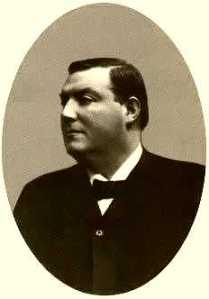
 With it’s Bo Diddley-inspired guitar riff and flamenco-meets-Rock ‘n’ Roll feel, 1961’s (Marie’s The Name) His Latest Flame served as a welcome, albeit temporary, break from Elvis’ succession of easy listening fare such as It’s Now Or Never, Surrender and Are You Lonesome Tonight (though within a few months, he’d top the charts with another standard ballad, Can’t Help Falling In Love). Like these songs, His Latest Flame was not an original.
With it’s Bo Diddley-inspired guitar riff and flamenco-meets-Rock ‘n’ Roll feel, 1961’s (Marie’s The Name) His Latest Flame served as a welcome, albeit temporary, break from Elvis’ succession of easy listening fare such as It’s Now Or Never, Surrender and Are You Lonesome Tonight (though within a few months, he’d top the charts with another standard ballad, Can’t Help Falling In Love). Like these songs, His Latest Flame was not an original. The song was written by Doc Pomus and Mort Shuman, who wrote some 20 Elvis songs — including His Latest Flame’s b-side, Little Sister — as well as hits for acts such as The Drifters (Save The Last Dance For Me) and Dion (Teenager In Love). Although reportedly written specifically for Elvis, His Latest Flame was first offered to Bobby Vee, who turned it down. Del Shannon recorded the song in May 1961, with a view to releasing it as a follow-up single for his big hit Runaway. In the event, he decided to run with “Hats Off To Larry” instead. His Latest Flame was released on the Runaway With Del Shannon LP in June. The same month Elvis recorded his version, which was released in the US in August. Due to the arcane method of compiling the US charts, the His Latest Flame peaked at #4 and its flip side, Little Sister (another Pomus/Shuman composition) at #5. It topped the charts in Britain.
The song was written by Doc Pomus and Mort Shuman, who wrote some 20 Elvis songs — including His Latest Flame’s b-side, Little Sister — as well as hits for acts such as The Drifters (Save The Last Dance For Me) and Dion (Teenager In Love). Although reportedly written specifically for Elvis, His Latest Flame was first offered to Bobby Vee, who turned it down. Del Shannon recorded the song in May 1961, with a view to releasing it as a follow-up single for his big hit Runaway. In the event, he decided to run with “Hats Off To Larry” instead. His Latest Flame was released on the Runaway With Del Shannon LP in June. The same month Elvis recorded his version, which was released in the US in August. Due to the arcane method of compiling the US charts, the His Latest Flame peaked at #4 and its flip side, Little Sister (another Pomus/Shuman composition) at #5. It topped the charts in Britain.
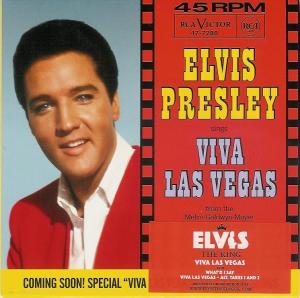 Doc Pomus and Mort Shuman also wrote the title song for Elvis’ 1964 movie vehicle, the title of which presages the singer’s future image (just think of the nauseating cliché of rhinestone-jumpsuited Elvis impersonators with comedy shades administering nuptial vows in a tacky plastic chapel in Vegas, the image of Elvis which threatens to destroy our boy’s rich legacy). The song has become one of the most popular from Elvis’ fallow mid-’60s period. Oddly, initially it was only the b-side to the lead single, the cover of Ray Charles What’d I Say (
Doc Pomus and Mort Shuman also wrote the title song for Elvis’ 1964 movie vehicle, the title of which presages the singer’s future image (just think of the nauseating cliché of rhinestone-jumpsuited Elvis impersonators with comedy shades administering nuptial vows in a tacky plastic chapel in Vegas, the image of Elvis which threatens to destroy our boy’s rich legacy). The song has become one of the most popular from Elvis’ fallow mid-’60s period. Oddly, initially it was only the b-side to the lead single, the cover of Ray Charles What’d I Say (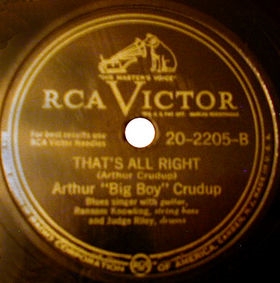 This is the song that changed Rock ‘n’ Roll forever. Young Elvis was in the Sun studios in Memphis, auditioning for the legendary Sam Phillips (in other accounts the story is set, more credibly, during the first recording session). Elvis, the story goes, was failing the audition, having crooned one ballad after another in Dean Martin mode. It was not the sound Phillips was looking for. During a break (or at the end of the session), Elvis starting goofing around with his guitar, singing That’s Allright, Arthur ‘Big Boy’ Crudup’s blues number from 1946. Session musicians Scotty Moore and Bill Black joined in. Sam Phillips later recalled: “The door to the control room was open, the mics were on, Scotty was in the process of packing up his guitar, I think Bill had already thrown his old bass down — he didn’t even have a cover for it — and the session was, to all intents and purposes, over. Then Elvis struck up on just his rhythm guitar, ‘That’s all right, mama..,’ and I mean he got my attention immediately. It could have been that it wouldn’t have sold ten copies, but that was what I was looking for!”
This is the song that changed Rock ‘n’ Roll forever. Young Elvis was in the Sun studios in Memphis, auditioning for the legendary Sam Phillips (in other accounts the story is set, more credibly, during the first recording session). Elvis, the story goes, was failing the audition, having crooned one ballad after another in Dean Martin mode. It was not the sound Phillips was looking for. During a break (or at the end of the session), Elvis starting goofing around with his guitar, singing That’s Allright, Arthur ‘Big Boy’ Crudup’s blues number from 1946. Session musicians Scotty Moore and Bill Black joined in. Sam Phillips later recalled: “The door to the control room was open, the mics were on, Scotty was in the process of packing up his guitar, I think Bill had already thrown his old bass down — he didn’t even have a cover for it — and the session was, to all intents and purposes, over. Then Elvis struck up on just his rhythm guitar, ‘That’s all right, mama..,’ and I mean he got my attention immediately. It could have been that it wouldn’t have sold ten copies, but that was what I was looking for!” Eleven days before the single was released on 19 July 1954, Memphis radio DJ Dewey Phillips played it seven times in a row by popular request. In an on air interview, he asked Elvis (whom, according to legend, he first called Elton Preston) which high school he had attended — a euphemistic way of clarifying for his listeners that Elvis was in fact white. Elvis has often been accused of hijacking black music, turning it white. If that was the effect, it was not Elvis’ plan. Here was a boy with a real affinity for R&B (as well as for gospel, country and the crooners). In 1956 he said: “The coloured folks been singing it and playing it just like I’m doin’ now, man, for more years than I know… I used to hear old Arthur Crudup bang his box the way I do now and I said if I ever got to the place where I could feel what old Arthur felt, I’d be a music man like nobody ever saw.”
Eleven days before the single was released on 19 July 1954, Memphis radio DJ Dewey Phillips played it seven times in a row by popular request. In an on air interview, he asked Elvis (whom, according to legend, he first called Elton Preston) which high school he had attended — a euphemistic way of clarifying for his listeners that Elvis was in fact white. Elvis has often been accused of hijacking black music, turning it white. If that was the effect, it was not Elvis’ plan. Here was a boy with a real affinity for R&B (as well as for gospel, country and the crooners). In 1956 he said: “The coloured folks been singing it and playing it just like I’m doin’ now, man, for more years than I know… I used to hear old Arthur Crudup bang his box the way I do now and I said if I ever got to the place where I could feel what old Arthur felt, I’d be a music man like nobody ever saw.”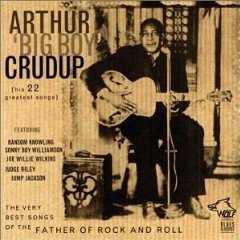 Elvis would record two more Crudup songs, My Baby Left Me and So Glad You’re Mine. If My Baby Left Me, which he recorded in 1949, sounds a lot like That’s Allright, it is because Crudup had a limited number of tunes which he adapted with new lyrics (usually also recycled). By coincidence, the man whose song set Elvis up with a career start at Sun Records had previously recorded for RCA (on their Bluebird subsidiary), the record company with which Elvis would break big. Crudup fought for the rest of his life to receive due royalties, making his living as a bootlegger and field labourer. In 1971, an agreement for $60,000 was agreed with Melrose Publishers, who proceeded to blankly refuse paying up. Crudup died penniless in 1974 at the age of 68.
Elvis would record two more Crudup songs, My Baby Left Me and So Glad You’re Mine. If My Baby Left Me, which he recorded in 1949, sounds a lot like That’s Allright, it is because Crudup had a limited number of tunes which he adapted with new lyrics (usually also recycled). By coincidence, the man whose song set Elvis up with a career start at Sun Records had previously recorded for RCA (on their Bluebird subsidiary), the record company with which Elvis would break big. Crudup fought for the rest of his life to receive due royalties, making his living as a bootlegger and field labourer. In 1971, an agreement for $60,000 was agreed with Melrose Publishers, who proceeded to blankly refuse paying up. Crudup died penniless in 1974 at the age of 68. Before the session, the story goes, RCA had procured the first recording of the Leiber/Stoller composition, Big Mama Thornton’s blues rendition. Everybody was aghast: they thought it was horrible, unable to comprehend why Elvis would want to record that, as Gordon Stoker of the vocal backing group The Jordanaires later recalled. Stoker and the other puzzled people in the studio obviously did not watch TV. A month before the recording session, Elvis had performed the song on The Milton Berle Show, more or less the way he was going to record it on 2 July (
Before the session, the story goes, RCA had procured the first recording of the Leiber/Stoller composition, Big Mama Thornton’s blues rendition. Everybody was aghast: they thought it was horrible, unable to comprehend why Elvis would want to record that, as Gordon Stoker of the vocal backing group The Jordanaires later recalled. Stoker and the other puzzled people in the studio obviously did not watch TV. A month before the recording session, Elvis had performed the song on The Milton Berle Show, more or less the way he was going to record it on 2 July ( The truth is that Elvis didn’t base his version on Big Mama Thornton at all, but on the cover by Freddie Bell and the Bellboys, An Ital0-American band he had seen during his discouraging concert engagement in Vegas in April/May 1956. Having ascertained that Bell wouldn’t mind, Elvis quickly included Hound Dog in his setlist. He probably was aware of Thornton’s version, and perhaps heard some of the country covers that had been released. But Elvis’ Hound Dog is entirely a reworking of the Bellboys’, incorporating their sound and modified lyrics (“Cryin’ all the time” for “Snoopin’ round my door”, “You ain’t never caught a rabbit, and you ain’t no friend of mine” for “You can wag your tail, but I ain’t gonna feed you no more”), but happily dispensing with the lupine howls.
The truth is that Elvis didn’t base his version on Big Mama Thornton at all, but on the cover by Freddie Bell and the Bellboys, An Ital0-American band he had seen during his discouraging concert engagement in Vegas in April/May 1956. Having ascertained that Bell wouldn’t mind, Elvis quickly included Hound Dog in his setlist. He probably was aware of Thornton’s version, and perhaps heard some of the country covers that had been released. But Elvis’ Hound Dog is entirely a reworking of the Bellboys’, incorporating their sound and modified lyrics (“Cryin’ all the time” for “Snoopin’ round my door”, “You ain’t never caught a rabbit, and you ain’t no friend of mine” for “You can wag your tail, but I ain’t gonna feed you no more”), but happily dispensing with the lupine howls. Bell and his band enjoyed a mostly undistinguished recording career, with only one real hit, Giddy Up A Ding Dong (which was much bigger in Europe than it was in the US), also in 1956. Bell got no writing credit for Hound Dog. The writing credit remained entirely with Jerry Leiber and Mike Stoller, who were still R&B-obsessed teenagers when they were commissioned by the producer Johnny Otis to write a song for Big Mama Thornton in 1952. They did so in 15 minutes (when the song became a million-seller for Elvis, Otis claimed co-authorship. He lost that case). Thornton’s recording became a #1 hit on the R&B charts in 1953 (
Bell and his band enjoyed a mostly undistinguished recording career, with only one real hit, Giddy Up A Ding Dong (which was much bigger in Europe than it was in the US), also in 1956. Bell got no writing credit for Hound Dog. The writing credit remained entirely with Jerry Leiber and Mike Stoller, who were still R&B-obsessed teenagers when they were commissioned by the producer Johnny Otis to write a song for Big Mama Thornton in 1952. They did so in 15 minutes (when the song became a million-seller for Elvis, Otis claimed co-authorship. He lost that case). Thornton’s recording became a #1 hit on the R&B charts in 1953 ( Three years after Thornton’s hit, Stoller honeymooning on board of the sinking Andrea Doria. His life was spared (and, like Leiber, he is still with us), and returning to New York, he was greeted at the pier by Leiber with the news that Hound Dog had become a smash hit. “Mama Thornton?” Stoller asked. “No, some white kid named Elvis Presley,” replied Leiber. The songwriters, R&B purists, resented Elvis’ version. When, inevitably, they were commissioned to write for Elvis a year later, for the Jailhouse Rock film, they were not particularly happy. As a form of revenge, Leiber wrote for Elvis to sing the line in the title track: “you’re the cutest little jailbird I ever did see.” The prison in Jailhouse Rock was not co-ed. When they finally met Elvis, the songwriters realised that Elvis was a kindred spirit who genuinely shared their love for R&B, and they became good friends. Stoller even appeared in the film, as a piano player.
Three years after Thornton’s hit, Stoller honeymooning on board of the sinking Andrea Doria. His life was spared (and, like Leiber, he is still with us), and returning to New York, he was greeted at the pier by Leiber with the news that Hound Dog had become a smash hit. “Mama Thornton?” Stoller asked. “No, some white kid named Elvis Presley,” replied Leiber. The songwriters, R&B purists, resented Elvis’ version. When, inevitably, they were commissioned to write for Elvis a year later, for the Jailhouse Rock film, they were not particularly happy. As a form of revenge, Leiber wrote for Elvis to sing the line in the title track: “you’re the cutest little jailbird I ever did see.” The prison in Jailhouse Rock was not co-ed. When they finally met Elvis, the songwriters realised that Elvis was a kindred spirit who genuinely shared their love for R&B, and they became good friends. Stoller even appeared in the film, as a piano player.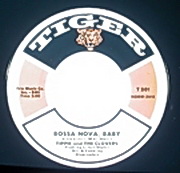 Another Leiber & Stoller composition, Bossa Nova Baby has been unjustly regarded by some as a bit of a displeasing novelty number from an Elvis movie (1963’s Fun In Acapulco). Even Elvis is said to have been embarrassed by it. If so, he had no cause: it may not be a bossa nova — it’s too fast for that — but it has a infectious tune and a genius keyboard riff which begs to be sampled widely. Perhaps it was the lyrics which had Elvis allegedly shamefaced, but the lines “she said, ‘Drink, drink, drink/Oh, fiddle-de-dink/I can dance with a drink in my hand’” are not much worse than some of the doggerel our man was forced to croon in his movie career as singing racing driver/pineapple heir/bus conductor. Or perhaps Elvis was embarrassed by the idea of including a notional bossa nova number in a movie set in Mexico.
Another Leiber & Stoller composition, Bossa Nova Baby has been unjustly regarded by some as a bit of a displeasing novelty number from an Elvis movie (1963’s Fun In Acapulco). Even Elvis is said to have been embarrassed by it. If so, he had no cause: it may not be a bossa nova — it’s too fast for that — but it has a infectious tune and a genius keyboard riff which begs to be sampled widely. Perhaps it was the lyrics which had Elvis allegedly shamefaced, but the lines “she said, ‘Drink, drink, drink/Oh, fiddle-de-dink/I can dance with a drink in my hand’” are not much worse than some of the doggerel our man was forced to croon in his movie career as singing racing driver/pineapple heir/bus conductor. Or perhaps Elvis was embarrassed by the idea of including a notional bossa nova number in a movie set in Mexico. Jerry Reed was a country singer who toiled for a dozen years before scoring a hit in 1967 with Tupelo Mississippi Flash — a song about Elvis. The same year Elvis chose to record Reed’s Guitar Man (the composer is listed as Jerry Hubbard, the singer’s real surname), and Reed played guitar on it. In 1968, Elvis also had a hit with Reed’s US Male, originally written in 1966. Reed, who died last August, had enjoyed some success as a songwriter before (such as Johnny Cash’s A thing called love) and later became a three-time Grammy winner, including one for his 1970 LP of duets with occasional Elvis associate Chet Atkins, and part-time movie actor, usually as a Burt Reynolds sidekick.
Jerry Reed was a country singer who toiled for a dozen years before scoring a hit in 1967 with Tupelo Mississippi Flash — a song about Elvis. The same year Elvis chose to record Reed’s Guitar Man (the composer is listed as Jerry Hubbard, the singer’s real surname), and Reed played guitar on it. In 1968, Elvis also had a hit with Reed’s US Male, originally written in 1966. Reed, who died last August, had enjoyed some success as a songwriter before (such as Johnny Cash’s A thing called love) and later became a three-time Grammy winner, including one for his 1970 LP of duets with occasional Elvis associate Chet Atkins, and part-time movie actor, usually as a Burt Reynolds sidekick. We’ll take a look at the more famous hit from Elvis’ 1961 movie Blue Hawaii — one of his most popular and the one with his best-selling soundtrack — in the next Elvis Originals Special on Friday.
We’ll take a look at the more famous hit from Elvis’ 1961 movie Blue Hawaii — one of his most popular and the one with his best-selling soundtrack — in the next Elvis Originals Special on Friday.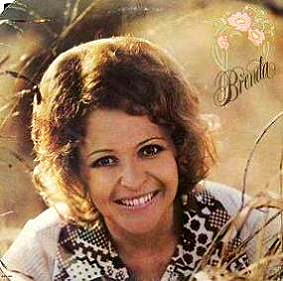 Depending on where you live and how old you are, this may be Elvis’ song or Willie Nelson’s, or perhaps the Pet Shop Boys’ (who had a hit with it in late 1987 after earlier performing it on a TV special to mark the 10th anniversary of Elvis’ death). Originally it was Brenda Lee’s, released in May 1972. It was not a big hit for her, reaching only #45 in the country charts. Somehow Elvis heard it and found the lyrics expressed his emotions at a time when the marriage to Priscilla was collapsing. He recorded it later in 1972. Released as the b-side to the top 20 hit Separate Ways, Always On My Mind was a #16 hit in the country charts. In the UK, however it was a top 10 hit, and became better know in Europe than in the US.
Depending on where you live and how old you are, this may be Elvis’ song or Willie Nelson’s, or perhaps the Pet Shop Boys’ (who had a hit with it in late 1987 after earlier performing it on a TV special to mark the 10th anniversary of Elvis’ death). Originally it was Brenda Lee’s, released in May 1972. It was not a big hit for her, reaching only #45 in the country charts. Somehow Elvis heard it and found the lyrics expressed his emotions at a time when the marriage to Priscilla was collapsing. He recorded it later in 1972. Released as the b-side to the top 20 hit Separate Ways, Always On My Mind was a #16 hit in the country charts. In the UK, however it was a top 10 hit, and became better know in Europe than in the US.













































Recent Comments